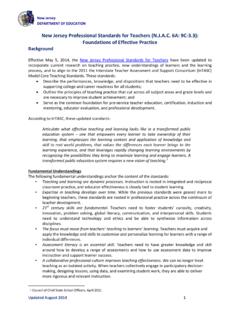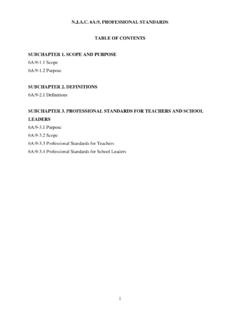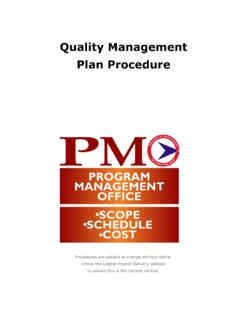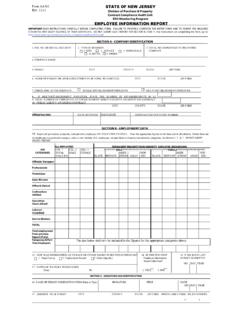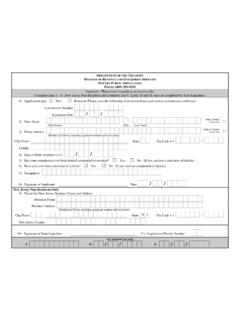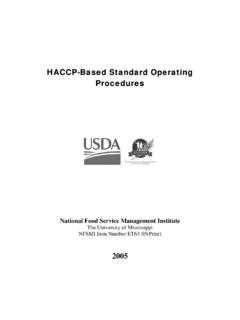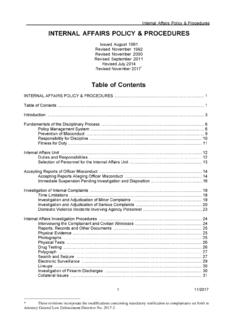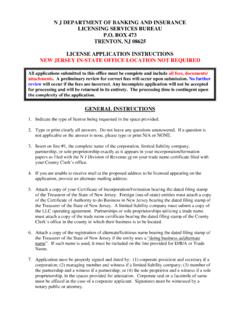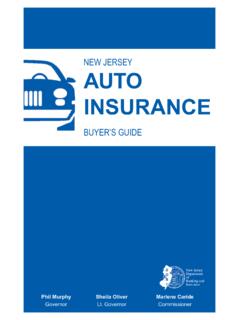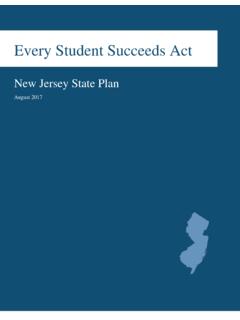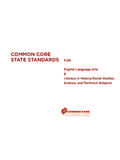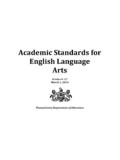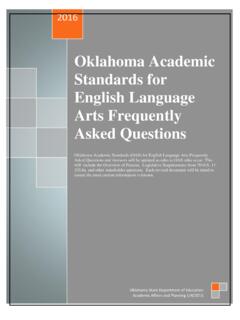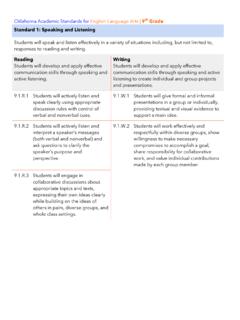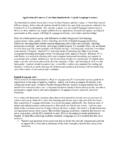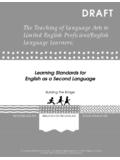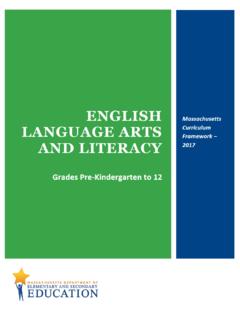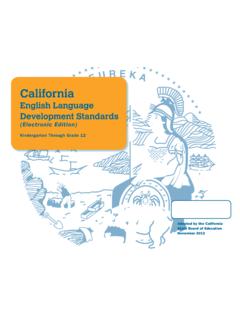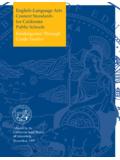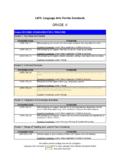Transcription of New Jersey Student Learning Standards for English Language ...
1 New Jersey Student Learning Standards for English Language Arts Grades 11-12. The Standards define general, cross-disciplinary literacy expectations that must be met for students to be prepared to enter college and workforce training programs ready to succeed. The K 12 grade-specific Standards define end-of-year expectations and a cumulative progression designed to enable students to meet college and career readiness expectations no later than the end of high school. Students advancing through the grades are expected to meet each year's grade-specific Standards , retain or further develop skills and understandings mastered in preceding grades, and work steadily toward meeting the more general expectations described by the Standards . Anchor Standards for Reading Key Ideas and Details Read closely to determine what the text says explicitly and to make logical inferences and relevant connections from it; cite specific textual evidence when writing or speaking to support conclusions drawn from the text.
2 Determine central ideas or themes of a text and analyze their development; summarize the key supporting details and ideas. Analyze how and why individuals, events, and ideas develop and interact over the course of a text. Craft and Structure Interpret words and phrases as they are used in a text, including determining technical, connotative, and figurative meanings, and analyze how specific word choices shape meaning or tone. Analyze the structure of texts, including how specific sentences, paragraphs, and larger portions of the text ( , a section, chapter, scene, or stanza) relate to each other and the whole. Assess how point of view or purpose shapes the content and style of a text. Integration of Knowledge and Ideas Integrate and evaluate content presented in diverse media and formats, including visually and quantitatively, as well as in words.
3 Delineate and evaluate the argument and specific claims in a text, including the validity of the reasoning as well as the relevance and sufficiency of the evidence. Analyze and reflect on how two or more texts address similar themes or topics in order to build knowledge or to compare the approaches the authors take. Read and comprehend complex literary and informational texts independently and proficiently with scaffolding as needed. Page 1 of 13. New Jersey Student Learning Standards for English Language Arts Note on range and content of Student reading To become college and career ready, students must grapple with works of exceptional craft and thought whose range extends across genres, cultures, and centuries. Such works offer profound insights into the human condition and serve as models for students' own thinking and writing.
4 Along with high-quality contemporary works, these texts should be chosen from among seminal documents, the classics of American literature, and the timeless dramas of Shakespeare. Through wide and deep reading of literature and literary nonfiction of steadily increasing sophistication, students gain a reservoir of literary and cultural knowledge, references, and images; the ability to evaluate intricate arguments; and the capacity to surmount the challenges posed by complex texts. Grades 11-12. Progress Indicators for Reading Literature Key Ideas and Details Cite strong and thorough textual evidence and make relevant connections to support analysis of what the text says explicitly as well as inferences drawn from the text, including determining where the text leaves matters uncertain. Determine two or more themes or central ideas of a text and analyze their development over the course of the text, including how they interact and build on one another to produce a complex account; provide an objective summary of the text.
5 Analyze the impact of the author's choices regarding how to develop and relate elements of a story or drama ( , where a story is set, how the action is ordered, how the characters are introduced and developed). Craft and Structure Determine the meaning of words and phrases as they are used in the text, including figurative and connotative meanings; analyze the impact of specific word choices on meaning and tone, including words with multiple meanings or Language that is particularly fresh, engaging, or beautiful. ( , Shakespeare as well as other authors.). Analyze how an author's choices concerning how to structure specific parts of a text ( , the choice of where to begin or end a story, the choice to provide a comedic or tragic resolution) contribute to its overall structure and meaning as well as its aesthetic impact.
6 Analyze a case in which grasping a point of view requires distinguishing what is directly stated in a text from what is really meant ( , satire, sarcasm, irony, or understatement). Page 2 of 13. New Jersey Student Learning Standards for English Language Arts Integration of Knowledge and Ideas Analyze multiple interpretations of a story, drama, or poem ( , recorded or live production of a play or recorded novel or poetry), evaluating how each version interprets the source text. ( , Shakespeare and other authors.). (Not applicable to literature). Demonstrate knowledge of and reflect on ( practical knowledge, historical/cultural context, and background knowledge) eighteenth-, nineteenth- and early twentieth-century foundational works of literature, including how two or more texts from the same period treat similar themes or topics.
7 Range of Reading and Level of Text Complexity By the end of grade 11, read and comprehend literature, including stories, dramas, and poems at grade level text-complexity or above with scaffolding as needed. By the end of grade 12, read and comprehend literature, including stories, dramas, and poems, at grade level or above. Grades 11-12. Progress Indicators for Reading Informational Text Key Ideas and Details Accurately cite strong and thorough textual evidence, ( , via discussion, written response, etc.), to support analysis of what the text says explicitly as well as inferentially, including determining where the text leaves matters uncertain. Determine two or more central ideas of a text, and analyze their development and how they interact to provide a complex analysis; provide an objective summary of the text.
8 Analyze a complex set of ideas or sequence of events and explain how specific individuals, ideas, or events interact and develop over the course of the text. Craft and Structure Determine the meaning of words and phrases as they are used in a text, including figurative, connotative, and technical meanings; analyze how an author uses and refines the meaning of a key term or terms over the course of a text ( , how Madison defines faction in Federalist No. 10). Analyze and evaluate the effectiveness of the structure an author uses in his or her exposition or argument, including whether the structure makes points clear, convincing, and engaging. Determine an author's point of view or purpose in a text in which the rhetoric is particularly effective, analyzing how style and content contribute to the power, persuasiveness or beauty of the text.
9 Page 3 of 13. New Jersey Student Learning Standards for English Language Arts Integration of Knowledge and Ideas Integrate and evaluate multiple sources of information presented in different media or formats ( , visually, quantitatively) as well as in words in order to address a question or solve a problem. Describe and evaluate the reasoning in seminal and global texts, including the application of constitutional principles and use of legal reasoning ( , in Supreme Court majority opinions and dissents). and the premises, purposes, and arguments in works of public advocacy ( , The Federalist, presidential addresses). Analyze and reflect on ( practical knowledge, historical/cultural context, and background knowledge) documents of historical and literary significance for their themes, purposes and rhetorical features, including primary source documents relevant to and/or global history.
10 Range of Reading and Level of Text Complexity By the end of grade 11, read and comprehend literary nonfiction at grade level text-complexity or above with scaffolding as needed. By the end of grade 12, read and comprehend literary nonfiction at grade level text-complexity or above. Page 4 of 13. New Jersey Student Learning Standards for English Language Arts Anchor Standards for Writing Text Types and Purposes Write arguments to support claims in an analysis of substantive topics or texts, using valid reasoning and relevant and sufficient evidence. Write informative/explanatory texts to examine and convey complex ideas and information clearly and accurately through the effective selection, organization, and analysis of content. Write narratives to develop real or imagined experiences or events using effective technique, well-chosen details, and well-structured event sequences.
